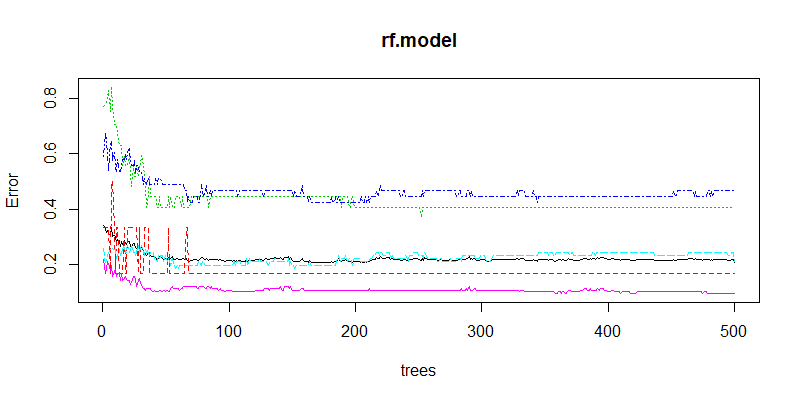データセットの準備
1 2 3 4 5 6 7 8 9 10 11 12 13 14 15 16 17 18 19 20 | library (randomForest)# データの概要 DV1 DV2 DV3 DV4 DV5 DV6 DV7 DV8 DV9 IV1 0 0 4 4 4 5 5 5 5 42 0 0 4 5 5 5 5 5 5 53 0 0 4 4 4 5 3 4 4 54 0 0 4 5 4 3 5 5 5 55 0 0 5 4 2 5 5 5 5 56 0 0 4 4 4 4 4 4 4 4# ランダムサンプリングの結果(乱数)を固定set.seed (100)# データのx%を抽出しトレーニング・テストデータに分けるsmpl <- sample(nrow(dat), 0.3*nrow(dat))train <- dat[smpl, ]test <- dat[-smpl, ]# データセットを説明変数と予測変数に分けるfeatures <- train[1 : 9]labels <- train[10]# 予測変数をファクターに変換する(カテゴリ変数の場合)labels <- as.factor(labels[[1]]) |
モデルを作成する
1 2 | # Model Descriptionrf.model <- randomForest(x = features, y = labels, importance = TRUE, proximity = TRUE) |
結果の可視化
1 2 3 4 5 6 7 8 | # 説明変数の重要度を表示・プロットするimp <- importance(rf.model, scale = FALSE)print(imp, digits = 4)dotchart(sort(imp [, 7]), xlab = "ジニ係数の平均減少量", ylab = "", main = "各項目の重要度")# 予測変数内の類似度を多次元尺度法で図示MDSplot(rf.model, dat$IV)# 機械学習の収束状況をプロットplot(rf.model) |



最適な特徴量とtreeの数を調べてモデルを再構築
1 2 3 4 5 6 7 8 9 10 11 12 13 14 15 | rfTuning <- tuneRF(x = features, y = labels, stepFactor = 2, improve = 0.05, trace = TRUE, plot = TRUE, doBest = TRUE)rf.model2 <- randomForest( x = features, y = labels, mtry = 6, #エラーの最も低いmtry数を指定 ntree = 200, #モデルが収束したntreeを指定 importance = T )# 分類の正確さの確認prdct <- predict(rf.model2, newdata = test)table(prdct, test$IV)correctAns <- 0 for (i in 1:nrow (table (prdct, test$IV)))correctAns <- correctAns + table (prdct, test$IV) [i, i]correctAns/nrow (test) |